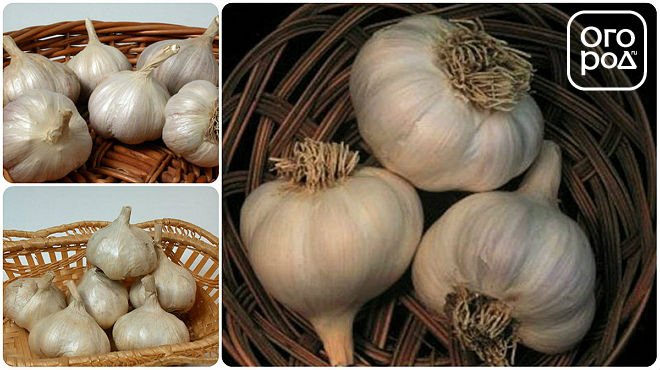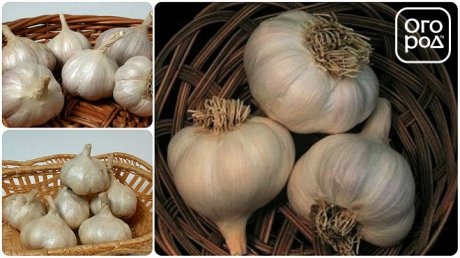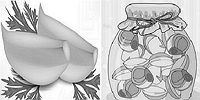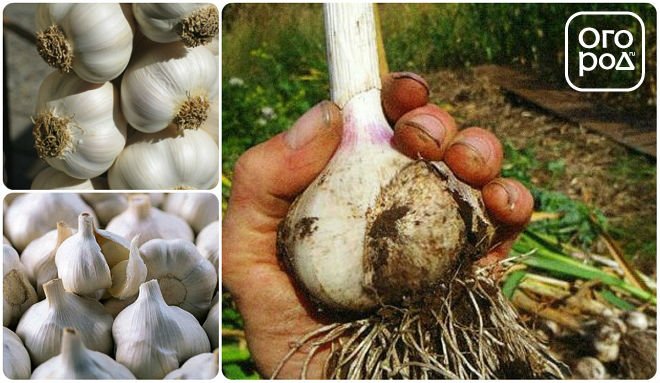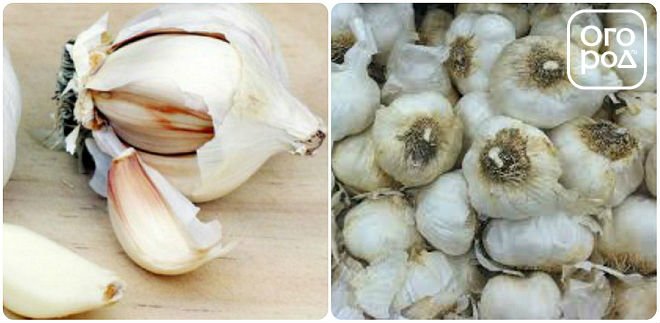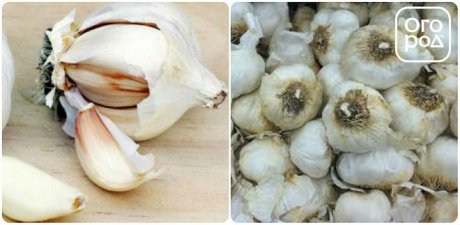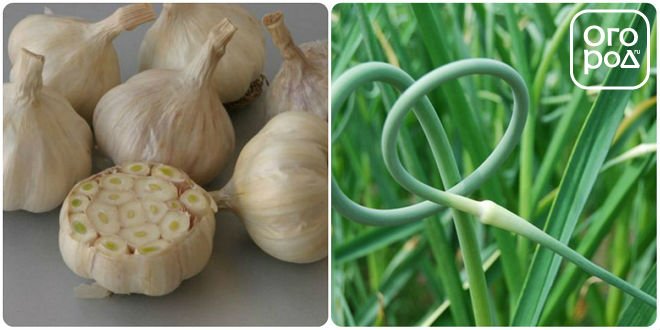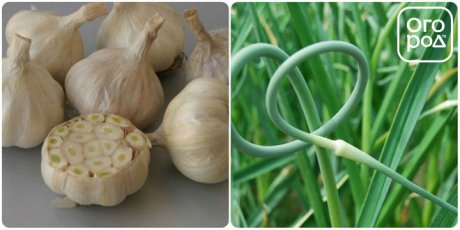Messidor a grade of garlic - the description seeds cultivation. What garlic plant in winter
Gardeners, as a rule, do not know which variety grows in their garden. Local populations are mainly grown or Turkish and Chinese food garlic are used as planting material. However, there are many varieties of garlic with high commodity and food qualities.
Winter garlic varieties
On the market there are both old Soviet varieties and new ones obtained relatively recently. As of 2017, 73 varieties of winter garlic are included in the State Register. Seed material goes on sale in limited quantities, but still find it is not so difficult. In stores, also, you can find varieties that are not included in the registry.
General characteristics of varieties
Most varieties have no restrictions on growing areas. The exceptions are the varieties Autumn (for cultivation in the West Siberian region) and Petrovsky (for the Middle Volga region).
The varieties of garlic have the following characteristics.
Productivity In winter garlic, it is quite high (from 0.9 kg / m2 and above). There are varieties with low yields, but with other advantages (resistance to pests, diseases, long shelf life, etc.).
Storage shelf storage. Winter garlic is well kept for 6 months. There are several varieties with high keeping quality - up to 7-8 months. Reliable grade is stored up to 11 months.
Ability to bolting. Winter garlic can be arrowhead and non-arrow. Non-shooting varieties are Bogolepovsky, Vityaz, Doctor, Novosibirsk, Pamyati Ershov, Spika. The rest of the varieties of arrows.
Taste may be sharp or semi-sharp.
In terms of ripening varieties are divided into:
- early maturing - 80-90 days (Love, Dragoon, Novosibirsk, Autumn, Cyr 10);
- mid-season - 90-120 days;
- late ripening - more than 120 days (Altair, Dobrynya).
The ripening time is greatly influenced by weather conditions.
Description of winter garlic varieties
Here is a description of the most promising or proven high quality varieties.
Bogatyr
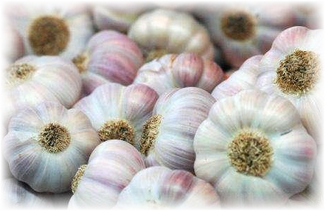
Mid-season grade. The leaves are of medium length 2.5 cm wide. The heads are very large, dense, rounded flat. The head is dense, the structure of the teeth is simple. The color of dry integumentary scales is white, the leathery scales are purple, and the flesh is white.
- yield 2.2-2.5 kg / m2;
- head mass 80 -115 g;
- number of teeth 7-8;
- taste is spicy;
- shelf life of 9 months.
Benefits. The variety is fruitful with very large teeth, winter-hardy, with a long shelf life.
disadvantages. At the slightest delay in cleaning the heads crack.
Bogolepovsky
Plants of medium ripe ripening, non-pointed. The bulbs are large, rounded flat, the structure of the cloves is simple. Leaves with a waxy coating of medium intensity up to 60 cm long, 2.7 cm wide. The covering and leathery scales are white, the flesh is white.
- yield of 2.6 kg / m2;
- head weight 60 g;
- number of teeth 12-14;
- shelf life of 6 months.
The advantages of the variety. High-yielding, large heads, many teeth in the bulb.
disadvantages. Taste largely depends on weather conditions.
Love
![]()
New promising early ripe winter varieties of garlic. The leaves are long (59 cm) and wide (4.4 cm) with a waxy coating. The bulbs are very large, the structure of the teeth is simple. Dry scales are white, leathery - cream. The flesh is white dense.
- yield of 2.2 kg / m2;
- head mass 93 g;
- number of teeth 7;
- taste is spicy;
- shelf life of 6 months.
Benefits. Very large heads, high yield.
disadvantages. The variety has recently appeared on the market, so there are no defects yet.
Reliable
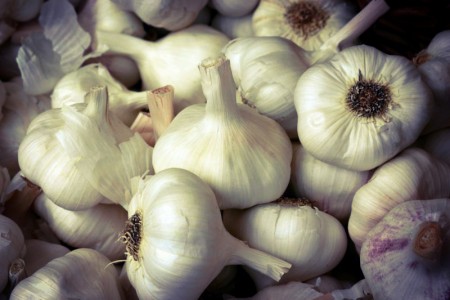
Medium ripening plants, arrowheads. The leaves are very short and narrow, which is uncharacteristic of winter garlic, with an average wax coating, 1.1 cm long, 1.5-2 cm wide. The bulb is dense, round. The outer scales are white with a lilac shade, the teeth are white, dense.
- yield of 1.2 kg / m2;
- head weight 60 -70 g;
- number of teeth 6-7;
- taste is spicy;
- shelf life 11 months in a warm room.
Benefits. Good yield, excellent keeping quality, winter hardiness.
Disadvantages. Lack of sales of planting material.
Novosibirsk
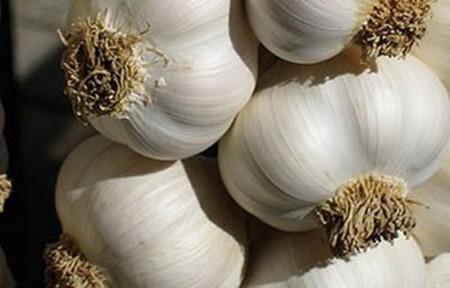
Old Soviet variety of winter garlic, not lost its qualities to the present. Plants early ripening. The growing season is 75-81 days. Variety does not arrow. Leaves with a faint or medium waxy coating, dark green, 27.3 cm long and 1.2 cm wide. The bulbs are rounded-flat, aligned, medium density, having 4-6 cover scales of pale pinkish color. Clove mass 2.5 g.
- yield of 1.04 kg / m2;
- head weight 20-22 g;
- number of teeth 4-10;
- taste is semi-sharp;
- shelf life of 6 months.
Benefits. Good productivity, leveled heads, high winter hardiness, resistance to bottom rot (Fusarium).
Disadvantages. Because of the loose bulb, the cloves dry very quickly.
In memory of Yershov

Middle-ripe plants do not shoot. Leaves 48 cm long, 2.8 cm wide with a medium waxy coating. The bulb is rounded flat, dry and leathery white scales, the flesh is white.
- yield 1.9 kg / m2;
- head weight 55 g;
- number of teeth 20;
- taste is semi-sharp;
- shelf life of 5 months.
Benefits. High productivity, winter hardiness.
Disadvantages. Small shelf life.
Rusich
The plants are middle ripening. Leaves with a medium or strong wax bloom up to 60 cm long, 2.2-2.7 cm wide. The head is rounded-flat, the teeth are simple, the covering scales are yellowish-white, leathery - brown. The structure of the teeth is simple. Pulp cream color.
- yield 2.5 kg / m2;
- head weight up to 70 g;
- number of teeth 5-6;
- taste is semi-sharp;
- shelf life of 6 months.
Benefits. Excellent high-yielding, winter-hardy garlic.
Disadvantages. Not found.
Scorpio
Another new promising variety. The plants are middle ripening. The leaves are long (54 cm) and wide (1.9 cm). The bulbs are large, round in shape, the teeth are simple with white flesh. Dry surface scales lilac purple, leathery - brown.
- yield of 2.0 kg / m2;
- head mass 63 g;
- number of teeth 5-7;
- taste is spicy;
- shelf life of 6 months.
Benefits. High productivity, winter hardiness, versatility of use.
Disadvantages. Lack of seeds for sale.
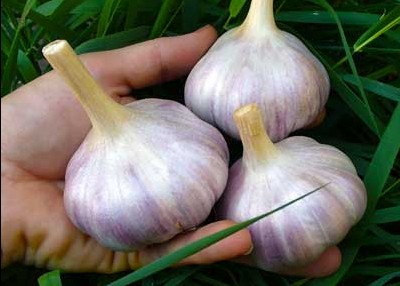
Plants mid-season ripening, arrow. Leaves 51 cm long, 2.3 cm wide with a medium waxy coating. The bulb is rounded-flat, dry scales are lilac-purple, leathery - brown, white flesh.
- yield 2kg / m2;
- head weight 65 g;
- number of teeth 5-7;
- taste is spicy;
- shelf life of 6 months.
Benefits. High productivity, winter hardiness.
Disadvantages. Strongly dries during storage.
Caesar
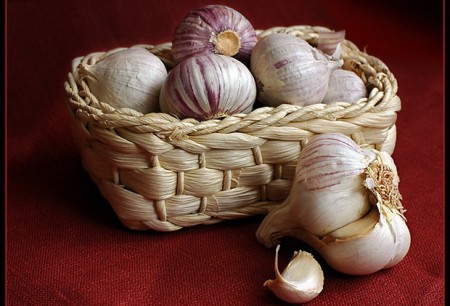
The plants are mid-season. Gunmen. Leaves 48.3 cm long, 2.7 cm wide with a medium wax coating. The bulbs are rounded flat, dense, of different sizes. Cover scales dirty gray with purple stripes, number 5-6 pieces.
- yield of 0.9 kg / m2;
- head mass 39-54 g;
- number of teeth 4-5;
- taste is semi-sharp;
- shelf life of 6 months.
Benefits. Universal use, stable yield, rot resistance in Donets.
Disadvantages. Bulbs vary greatly in mass.
Spring varieties of garlic
There are much less spring varieties than winter crops, all of which were included in the register after 2000 (except for the Elenovsky variety).
general characteristics
Spring garlic, like winter, can be grown in all climatic regions. The exception is Elenovsky garlic, which is zoned for the North Caucasus and Crimea.
Characteristics of spring garlic.
Productivity significantly lower than winter garlic. A good yield is higher than 0.7 kg / m2.
Storage shelf higher than winter. Mainly stored 8-10 months, but there are varieties with less keeping quality.
Ability to bolt. Spring garlic does not shoot (except Gulliver variety).
Taste sharp and semi-sharp.
Ripening spring garlic has a little longer - 110-135 days.
Description of varieties of spring garlic
Abrek
Garlic non-streaked, mid-season. The leaves are long (40-58 cm) and narrow (1.3-1.7 cm), with an average wax coating. The head is round, small, the number of integumentary scales 5-6, they are white. The flesh is white, dense.
- yield of 0.7 kg / m2;
- head weight 26-30 g;
- number of teeth 15;
- taste is spicy;
- shelf life of 6-7 months.
Benefits. Good yield.
disadvantages. Small shelf life.
Victorio
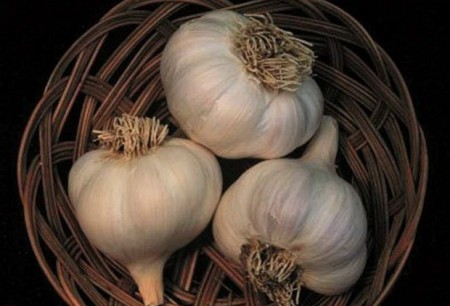
Good mid-season variety with high yield. Plants do not shoot, leaves 20-25 cm long, 1.1-1.3 cm wide, with a faint wax coating. The heads are large, rounded flat with a simple structure of the teeth. Dry surface scales are yellowish-white in color, 5-9 layers on a bulb. The flesh of the teeth is white.
- yield of 0.98 kg / m2;
- head mass 38-43 g;
- number of teeth 13-15;
- taste is semi-sharp;
- shelf life of 8 months.
Benefits. Excellent yield, large heads, resistance to rot of Donets.
Disadvantages. Not found.
Gulliver
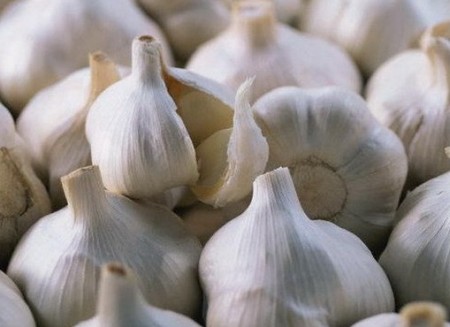
Medium late garlic. The leaves are 55 cm long and 4.2 cm wide with a strong waxy coating. The bulb is very large, rounded flat, integumentary scales of dirty-gray color in the amount of 4-5 pieces. The flesh is dense white.
- yield of 0.98 kg / m2;
- head weight 90-120 g;
- number of teeth 3-5;
- taste is spicy;
- shelf life of 8 months.
Benefits. Very large heads, high yield.
Disadvantages. A small number of teeth.
Countryman
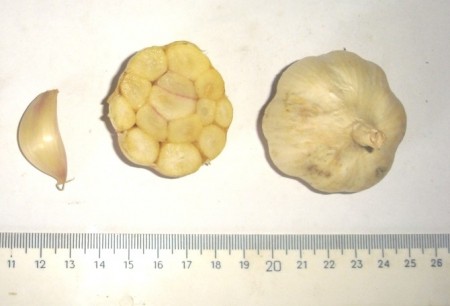
The plants are mid-season, non-strelka. Leaves with a faint wax bloom 37 cm long, 1.4 cm wide. The head is rounded with a complex structure. The color of the outer scales white, leathery - cream. The flesh is white.
- yield 0.3 kg / m2;
- head weight 29 g;
- number of teeth 15-16;
- taste is semi-sharp;
- shelf life of 10 months.
Benefits. Good lezhkost.
Disadvantages. Low yield.
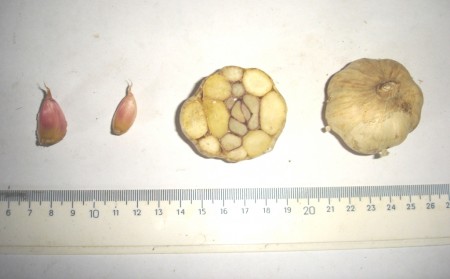
Spring garlic, mid-season, non-shot. The leaves are light green, covered with a faint wax bloom 32 cm long, 2.3 cm wide. The head is rounded flat with a complex tooth structure. White integumentary scales with anthocyanin touches, leathery - pink. The flesh of the teeth is white.
- yield 0.3 kg / m2;
- head weight 34 g;
- number of teeth 16-17;
- taste is semi-sharp;
- shelf life of 10 months.
Benefits. Long shelf life, large heads.
Disadvantages. Low productivity.
Porechye
The garlic is mid-season, non-shot. Leaf length 48 cm, width 1.6 cm, they are covered with a waxy coating of medium intensity. The bulbs are rounded flat with a simple structure of cloves. Cover and leathery scales are white, the flesh is white.
- yield of 0.9 kg / m2;
- head weight 24 g;
- number of teeth 12-20;
- taste is semi-sharp;
- shelf life of 7 months.
Benefits. High yield.
Disadvantages. Small heads, low keeping quality.
Nugget
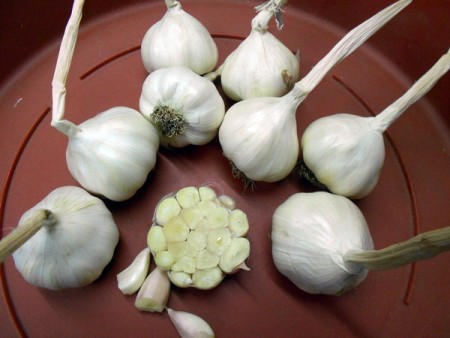
The plants are non-arrowed, mid-ripening. The leaves are long and narrow, their length 47 cm, width 1.6 cm, covered with a weak wax coating. The heads are rounded-flat, very large, the structure of the teeth is complex. Cover scales are white, leathery - pink. The flesh of zubkov is white.
- yield of 0.5 kg / m2;
- head weight 67 g;
- number of teeth 19-23;
- taste is semi-sharp;
- shelf life of 10 months.
Benefits. Good lezhkost.
Disadvantages. Despite the large mass of the bulb yield is low.
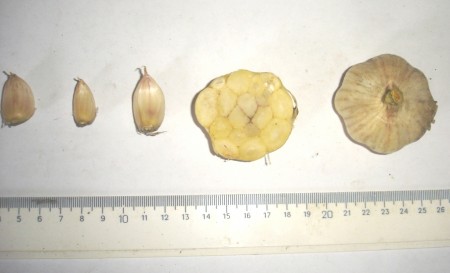
Spring garlic, mid-season non-shot. The leaves of the plants are light green, have a weak waxy coating, a length of 36 cm, a width of 1.1 cm. The heads are rounded flat with a complex structure of teeth. White dry scales with anthocyanin strokes, leathery - cream. The flesh of the teeth is white.
- yield 0.3 kg / m2;
- head weight 35 g;
- number of teeth 18-20;
- taste is semi-sharp;
- shelf life of 10 months.
Benefits. Long shelf life.
Disadvantages. Very low productivity.
Shunut
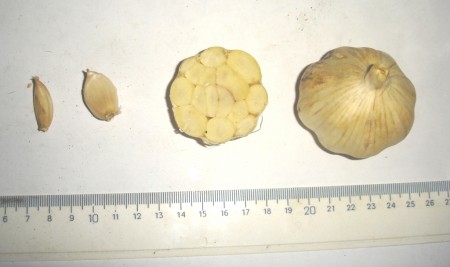
The plants are mid-season, non-strelka. Leaves 34 cm long, 1.4 cm wide, have an average wax deposit. The bulbs are large, rounded flat with a complex structure of cloves. Cover scales are white with anthocyanin touches, leathery - white, white flesh.
- yield of 0.4 kg / m2;
- head mass 47 g;
- number of teeth 13-16;
- taste is semi-sharp;
- shelf life of 10 months.
Benefits. Good lezhkost.
Disadvantages. Low yield.
Import Garlic Varieties
Messidor
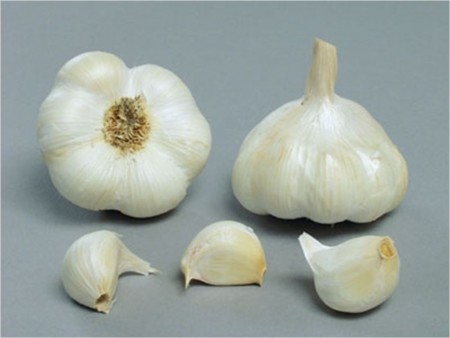
Dutch winter variety widely cultivated in our country. Plants mid-season universal purpose. Leaves from 16 to 40 cm in length and up to 2.5 cm in width, dark green. The bulbs are very large, the cloves are large, simple, juicy. Cover scales are white, leathery - purple. Disease resistance is high.
- yield 2.5 kg / m2;
- bulb weight 40 g;
- number of teeth 8-12;
- taste is spicy;
- shelf life of 5-6 months.
Benefits. Highly productive, resistant to diseases, universal purpose.
disadvantages. Cracks at the slightest delay in cleaning, dries strongly during storage.
Kledor
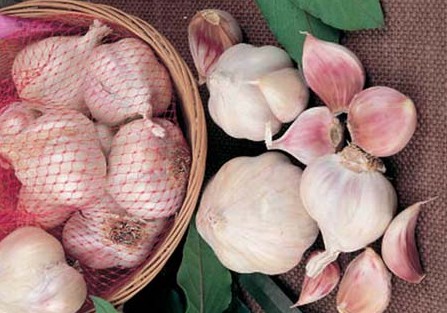
Spring garlic French selection. In Russia, it is becoming increasingly popular. Can be grown in the southern regions. The variety does not tolerate spring frosts, therefore it is not suitable for central areas. The plants are mid-maturing non-flicker. The heads are large, aligned. The color of the outer scales is light gray, the leathery scales are pink, and the flesh is light cream. Variety universal purpose. Resistant to fungal diseases.
- bulb weight 60-80 g;
- number of teeth 16-20;
- taste from semi-sharp to sharp;
- shelf life of 11 months.
Benefits. Versatility, disease resistance, large heads, excellent keeping quality.
Disadvantages. Low winter hardiness, the death of plants during the return spring frosts.
It is better to grow varieties of Russian breeding, which are not inferior in yield to European garlic, but are better suited to the climatic conditions of our country.
Dear visitors of the “Dacha plot”, tireless gardeners, gardeners and flower growers. We suggest you take a proficiency test and find out whether you can trust a shovel and let you with it in the garden.
Do you know how to distinguish spring garlic from winter and which varieties of spring garlic are considered the best? If not, be sure to read this article.
Today we will tell you about the peculiarities of spring garlic and which varieties are ideal for your site.
What makes spring garlic different from winter
Varieties of spring and winter garlic differ not only in terms of planting (spring is planted in spring, and winter in autumn). Very important indicators for them are the yield and shelf life. Spring varieties are usually less fruitful, but their bulbs can survive until the next harvest with virtually no losses. While winter varieties of garlic are mainly intended for fresh use and canning. And spring garlic (unlike winter) perfectly tolerates spring cooling. But they will not be able to survive the winter frosts.
Visually distinguish winter and spring garlic by the following features:
- winter garlic has a central core around which teeth are attached. If you separate all the cloves of garlic, then only such a "stick" will remain in the center. Spring garlic does not have such a central core.
- slices of spring garlic are arranged in a spiral in 2-3 rows (the closer to the center, the teeth are smaller), and winter teeth are placed neatly around the stem in 1 row.
- winter garlic has fewer teeth and they are more even in shape and size. But spring garlic has more lobules, and they can differ significantly from each other.
- spring garlic teeth are smaller in size, but larger in winter varieties, and the harvest is higher.
- spring varieties of garlic are non-gunned (except for the variety “Gulliver”), but winter crops are arrowed. They "throw out" arrows with air bulbs, which serve for reproduction.
To prepare the planting material, divide the garlic cloves and peel. After 4-5 days, sort them by size. Immediately remove all overdried, rotten and diseased specimens, and choose large and medium-sized healthy cloves for planting. Store garlic at a temperature of 16-20ºС, and 25-30 days before planting, transfer to a cool place with a temperature of 2-5ºС.
The best varieties of spring garlic
To get a good harvest, it is important to choose the right variety of spring garlic. We will talk about the 5 most popular and well-established varieties.
Victorio
Mid-season non-shot high-yielding variety. The bulbs are flat-rounded, with yellow-white dry scales. Disease resistant.
|
|
|||||
| Use | Taste | Number of teeth | Bulb weight (g) | Recumbency | |
|
semi-sharp | great | |||
Gulliver
Medium late arrow high-yielding variety. Bulbs dense, flat-round, scales dirty-white color. Resistant to diseases.
|
|
|||||
| Use | Taste | Number of teeth | Bulb weight (g) | Recumbency | |
|
|
acute | great | |||
Yelenovsky
Mid-season non-streaky variety. It has a stable yield and high quality products. Bulbs dense, round and flat-round. Outer scales are white, internal - creamy-pink. Resistant to major diseases of garlic.
|
|
|||||
| Use | Taste | Number of teeth | Bulb weight (g) | Recumbency | |
|
semi-sharp | the good | |||
Yershovsky
Mid-season non-shot high-yielding variety. The bulbs are flat-rounded, with white dry scales. Resistant to diseases.
|
|
|||||
| Use | Taste | Number of teeth | Bulb weight (g) | Recumbency | |
|
| |||||
Winter garlic
 According to the method of cultivation, the following types of garlic are distinguished:
According to the method of cultivation, the following types of garlic are distinguished:
- winter;
- spring.
In order for winter garlic to produce a crop, it needs to winter. Put him in September. Under the ground and snow garlic cloves endure even harsh winters. And in the spring among the first in the garden produce green shoots. Usually, winter varieties are shooters, which means that they can be propagated not only by planting cloves, but also by air bulbets. Winter varieties teeth are larger, spicy and juicy than spring ones.
To get a rich harvest of large heads of winter garlic, you need to take care in advance of planting material. For planting fit medium or large teeth without cracks and rot. Disinfect them in a solution of copper sulfate (4 grams per 1 liter of water) for half an hour.
In the State Register of Breeding Achievements, 59 varieties of winter garlic are listed. Let's call the most popular.
Lyubasha
Archery variety "Lyubasha" is resistant to both winter frosts and summer drought. This tall plant - the stem can reach 120 cm. The garlic head is round-flattened, large, with proper care it can weigh 120 grams. Its color is white or pinkish with purple streaks at the teeth. This is a versatile garlic - it can be eaten fresh or pickled. The taste is spicy. Variety "Lyubasha" has a strong immunity against disease. Well kept.
Sofievsky
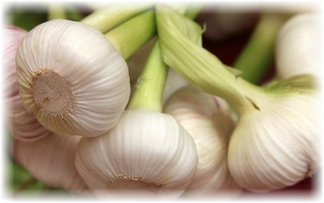 It is also a frost resistant variety. In the summer, it prefers a warm sunny place. Reaches an average height of 70 centimeters. The bulb is light purple in color, it can weigh 80-120 grams. The teeth are large - up to 20 grams. The variety of garlic is very productive, while the yield is stable. The variety contains genetic resistance to the nematode. In use is universal, has a spicy taste.
It is also a frost resistant variety. In the summer, it prefers a warm sunny place. Reaches an average height of 70 centimeters. The bulb is light purple in color, it can weigh 80-120 grams. The teeth are large - up to 20 grams. The variety of garlic is very productive, while the yield is stable. The variety contains genetic resistance to the nematode. In use is universal, has a spicy taste.
Alcor
Mid-season "Alcor" with an almost meter-long arrow is very fruitful. The pink bulb is round, with large teeth of a bluish-gray shade. The variety is susceptible to yellow dwarfism. Designed for use in cooking. Well kept.
A powerful and juicy arrow, which seemed to have grown from the very heart of the plant, deprives the garlic head of food. Therefore, when forming the bulb, carefully cut the arrow at the base. Do not break out - so you can damage the head.
Dobrynya
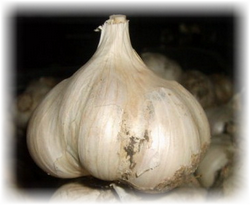 The "speaking" name of the variety reflects its truly heroic characteristics, although the maximum height of the stem and arrow is only 70 cm:
The "speaking" name of the variety reflects its truly heroic characteristics, although the maximum height of the stem and arrow is only 70 cm:
- onion weight - 50-60 grams;
- the number of even teeth in the head - 10-14;
- the average weight of a clove is 5-6 grams.
The advantages include yield, resistance to fusarium and excellent keeping quality. But when planting "Dobrynya" it is worth considering that he has an average frost resistance and late gestation period. The taste is not very spicy, so they like to eat it fresh.
Antonnik
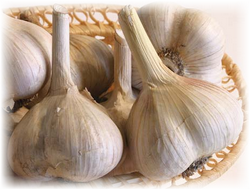 Strelkuyuschuyusya, mid-season variety with high yields and large bulbs grayish-white color. If the plant is planted in a sunny place, watered in time, the onion weight can reach 80 grams. "Antonnik" is resistant to fusarium. The taste is semi-sharp, the use is universal.
Strelkuyuschuyusya, mid-season variety with high yields and large bulbs grayish-white color. If the plant is planted in a sunny place, watered in time, the onion weight can reach 80 grams. "Antonnik" is resistant to fusarium. The taste is semi-sharp, the use is universal.
Dubkovsky
Arrowed, mid-season variety. The bulbs are not very large (29-32 grams), round-flat in shape and pale purple. Zubkov in the bulb - 10-12. The stem grows to 70 cm. The taste is sharp.
Dutch Messidor
Yield, mid-season, versatile variety. The stem reaches a height of 70 cm. The bulb is round, small - weighing 13-36 grams, purple. The number of teeth in it - up to 10 pieces, weighing 2-5 grams each. Disease resistant, well kept.
To keep garlic well, you need to dig it in time. Winter garlic is usually ready by mid-summer. The first sign is yellowed leaves. You can dig one head for the sample. If it is dense, then quietly dig out the rest. Garlic is better to harvest unripe than overripe. The latter is kept much worse.
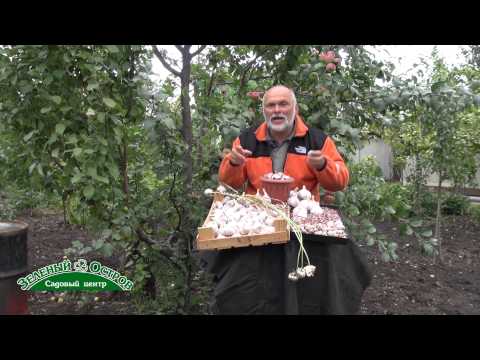
Doctor
Non-rifling, early ripe garlic with a rounded flat white onion. Its average weight is 36-42 grams. Teeth inside light pink or light purple. There are up to 16 pieces in one bulb. The taste of their semi-sharp. The height of the stem "Doctor" - 50-70 cm. The variety is hardy, productive and transportable.
Reliable
This is really a reliable variety with high winter hardiness, high disease resistance, with good keeping quality and excellent yield. Bulbs large with 5-7 teeth. The flesh is juicy, rich and sharp. The variety is mid-season.
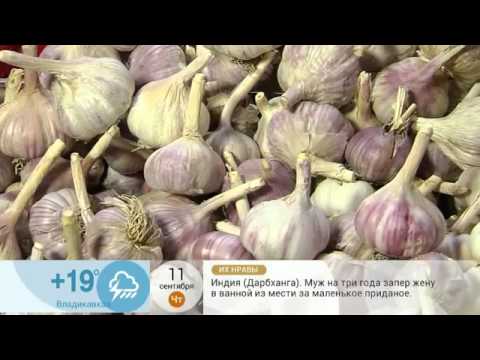
Hermidor
Dutch variety Hermidor ripens early. The head is large, it can grow up to 80 grams. The advantages include high yield, resistance to winter frosts and diseases. Suitable for long term storage.
Spring garlic
Spring garlic is usually planted in early spring, as early as April, and the bulbs ripen by autumn. In contrast to winter, the cloves of spring garlic are smaller, of different sizes, located around the center in several rows. These are usually non-streaked garlic varieties. Their yields are lower, but they are stored much better.
Varieties of spring garlic are much smaller than those of winter. We turn to the most common.
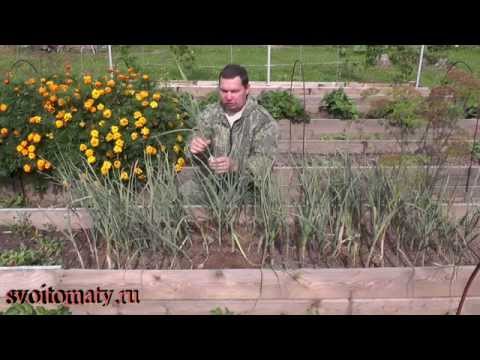
Gulliver
 The characteristics of this variety are more suitable for winter. The head is very large: it can weigh from 90 to 120 grams. Zubkov in the bulb is only 4-5, respectively, they are large and smooth. Medium Late Arrow. The taste is pleasant, medium hot.
The characteristics of this variety are more suitable for winter. The head is very large: it can weigh from 90 to 120 grams. Zubkov in the bulb is only 4-5, respectively, they are large and smooth. Medium Late Arrow. The taste is pleasant, medium hot.
The planting material of spring garlic is to undergo vernalization, that is, hold 2 months before planting in the cold, for example, in the refrigerator.
Aleisky
Mid-season grade without arrows. White bulbs are small, but family ones - inside 13-19 small teeth. Yield, resistant to fusarium.
Sochi 56
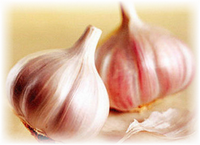 The plant does not arrow. The bulb ripens early, has a rounded flat shape, pink-purple color. Weight - up to 50 grams. Inside 25-30 pieces Zubkov.
The plant does not arrow. The bulb ripens early, has a rounded flat shape, pink-purple color. Weight - up to 50 grams. Inside 25-30 pieces Zubkov.
Sail
The variety is medium ripening, does not form an arrow. The bulb is round, small - up to 30 grams. The number of teeth varies from 4 to 8. Semi-sharp. Resistant to diseases.
Do not be late in planting spring garlic. Mid-April is the right time to plant it. Why? The root system of garlic is formed only at low temperatures and in dry soil.
Yelenovsky
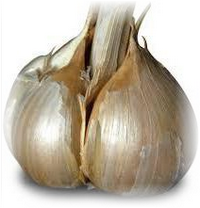 A new variety, was registered in 1999. Round heads are creamy pink in color. Grow up to an average of 30-40 grams. Not rifling, mid-season. Can be stored for up to 2 years.
A new variety, was registered in 1999. Round heads are creamy pink in color. Grow up to an average of 30-40 grams. Not rifling, mid-season. Can be stored for up to 2 years.
Flavor
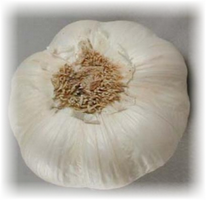 This foreign garlic is bred in France and distributed in the Mediterranean. But it fully matures even in Siberia. This juicy garlic with medium sharpness is like for preservation, and for cooking fresh dishes. Very well kept.
This foreign garlic is bred in France and distributed in the Mediterranean. But it fully matures even in Siberia. This juicy garlic with medium sharpness is like for preservation, and for cooking fresh dishes. Very well kept.
The usual head weight is 80 grams, it is pale pink in color. Small cloves are arranged in 2 rows: inside they are smaller. When growing starts up the arrow. According to maturity refers to the mid.
Kledor
And this garlic of French origin took root in central Russia, not to mention Ukraine and Belarus. The gentle-sharp taste of Kledor and its ability for long-term storage were to the liking of our gardeners. Heads of garlic are not very large, the teeth are arranged in a spiral. It has strong immunity to fungal diseases. Unrestricted, mid-season.
Vegetable growers try to grow both types of garlic of different varieties, because each has its own advantages.
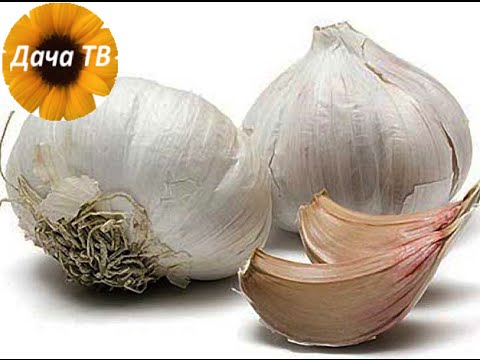
Garlic Dutch Messidor gives a yield of 500 kg from one weave. Suitable for growing on large fields, small garden areas.
Garlic Messidor is a valuable crop cultivated by farmers and private individuals in home gardens. Dutch variety suitable for market sales, long-term winter storage. Not particularly picky about the soil, quickly settled on the land expanses of our country.
Features of culture
For the first time grade Messidor was obtained in Holland. Due to its high yield and disease resistance, it quickly gained popularity in other countries.
Description of the variety:
The leaves are dark green, up to 70 cm long, up to 2.5 cm wide. From 8 to 12 of them can be in one culture. The bulb is round, the structure of the head is simple. One contains up to 14 teeth. The mass of each about 8 g. Bulb weight to 112 g. The head is white. Productivity is high - 500 kg of weave or 25 tons per hectare. The taste is bitter. The characteristic of useful substances - sugar 23.3%, ascorbic acid about 9 mg. Juicy, fragrant, with a beautiful presentation, early ripening, winter. Smell rich garlic.
The cultivation of garlic Messidor is carried out on flat land with good lighting, without the threat of flooding. Seeds are planted in the field, in the garden plots, in the garden, garden.
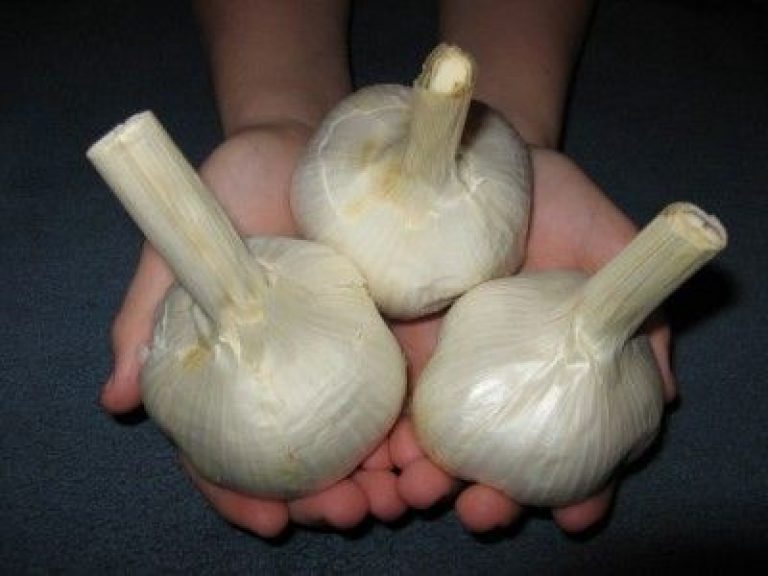
Growing technology:
- Garlic seeds Messidor for planting select the largest. If in one head up to 3 teeth, then the culture is reborn. The bulb is unusable.
If sick cloves are found, soak them in a weak solution of potassium permanganate or copper sulfate.
- Planting material should be updated every 3 years.
- The frequency of irrigation depends on the degree of dryness of the soil. Winter variety is not particularly picky about moisture. It is enough to water once a week during a drought.
- Top dressing is performed three times per season. During the period of active growth, ripening, before picking. In this case, the yield will be higher at times, and the teeth will remain juicy, beautiful.
- Weeds need to be removed carefully so as not to cut the leaves, not to damage the onion garlic bulbs of the winter variety Messidor.
- Planting varieties carried out in late September, early October.
- Collection is carried out in late June. Determine the time of the appearance of the leaves. If there are yellow leaves, it's time to collect. It is better to do this before being late. Overripe culture loses quality, appearance, is stored worse.
Without snow cover culture withstands 15 degrees of frost. In the presence of a small snow cover, temperatures up to -21 degrees are tolerable.
Soil preparation
Messidor gives great yield when it is planted on loamy soil with low acidity.
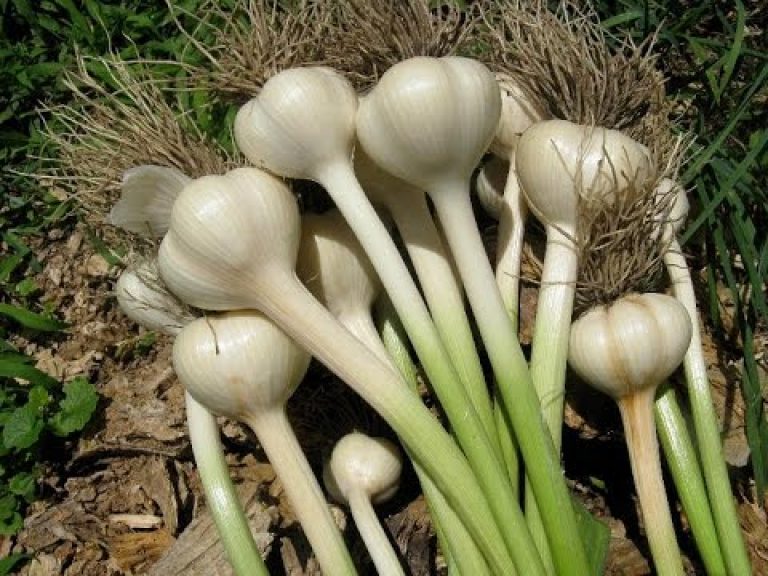
High rates of disease resistance and yield are observed after cucumbers, peppers, pumpkins, eggplants, tomatoes, cabbage, and early potatoes. You can not plant after late potatoes, radishes, carrots, turnips.
- It is not allowed to plant the culture in the same place. In this case, insect pests, fungi settle on the soil, infect the vegetable.
- The soil begins to prepare in the fall. They dig up a bed, disinfect. To do this, in 1 liter of water mix 1 g of boric acid, potassium permanganate, copper sulfate. On the eve of planting seeds fertilize the soil.
Fertilizer method - per 5 kg of humus 25 g of potassium salt, 30 g of double superphosphate.
- They dig to the depth of a shovel. Then cover with polyethylene before planting.
10 cubes are planted per running meter, spacing up to 120 cm. Planting depth not more than 6 cm, not less than 3 cm. Sand is added to the soil to make a good harvest. In this case, make grooves 15 cm deep, fall asleep by 3 cm sand. Spread the garlic with sharp teeth up. The distance between each up to 15 cm. The seeds are planted in the grooves with a depth of 3 cm. They are well watered, covered with earth.
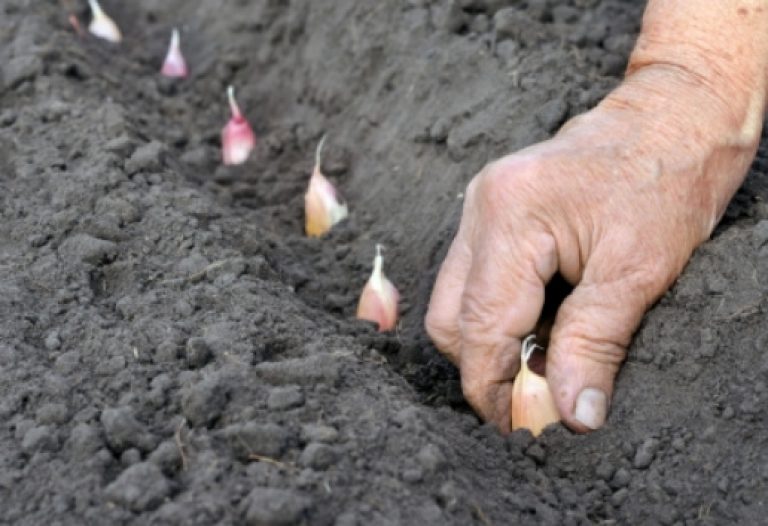
Collection dates
First of all, pay attention to the culture.
- lower leaves are yellow;
- inflorescence wrap cracks;
- on the bulb, the scale becomes thin.
Usually, the harvest period falls on the end of June. In the rainy cold summer period is extended to the beginning of August, hot and dry - the beginning of July. From the timely harvest depends on the quality of the vegetable, the duration of storage. This should be done on a warm sunny day in the first half. Leave to dry a little on the beds, by the end of the day collected. If you pick the vegetable too late, the onion will fall into the teeth, which will decrease the storage time. In addition, the vegetable will have time to take root, go deeper into the ground. Taste deterioration.
Garlic Dutch Messidor - a culture that does not require special care, but pleases with a high yield, juicy taste, large size!
Garlic - the most popular vegetable crop, which is grown in many parts of the world. Perennial plant with a spicy taste and a characteristic garlic smell. Garlic is particularly sensitive to changes in the growing environment, as a result, it is difficult to adapt to the change of the climatic zone. Therefore, when choosing planting material, one should give preference to zoned species, that is, adapted to local growing conditions.
It is important to remember that garlic is very demanding of regional climatic conditions and soil characteristics.
Winter garlic - how to choose a variety for planting in the winter
The State Register of Breeding Agricultural Plants includes two main types of garlic, which can be successfully cultivated in the Moscow region - spring and winter. Winter garlic is high-yielding, but poorly stored. Spring - less productive, but more lazy.
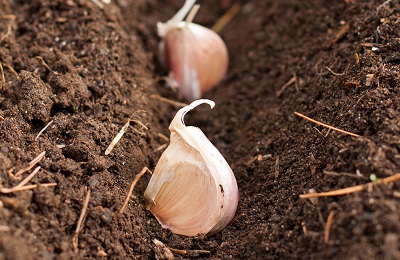 When the podzimny planting both species are well developed, but winter varieties of garlic are more productive. When spring planting, the picture is diametrically opposite - spring garlic gives a good harvest, and a single-tooth head grows from winter.
When the podzimny planting both species are well developed, but winter varieties of garlic are more productive. When spring planting, the picture is diametrically opposite - spring garlic gives a good harvest, and a single-tooth head grows from winter.
All types of winter garlic are divided into rifle and non-strelled. They can be easily distinguished by the following features:
- in the type of garlic shooter, the head consists of one ring of large cloves, the number of which varies from 4 to 12 pieces;
- an onion of a non-strelled variety consists of a large number of small cloves (14-30 pieces) arranged in a spiral.
The benefits of arrowhead garlic:
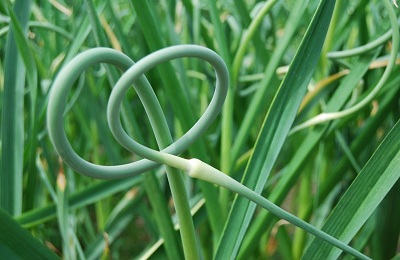
The arrows must be removed in a timely manner, as being late results in a decrease in yield (up to 30%). The unstretched variety is convenient because there is no need to get rid of the arrows.
For Moscow it is necessary to select cold-resistant varieties of winter garlic that can withstand low temperatures and freezing of the soil.
It is best to select planting material of domestic breeding, characterized by unpretentiousness and ease of care. Foreign species are more thermophilic, as a result of which they do not adapt well to the cold winter of the Moscow region regions.
The best zoned varieties of winter garlic
The most adapted to the climatic conditions of central Russia, in particular the Moscow region, are such winter varieties of garlic:
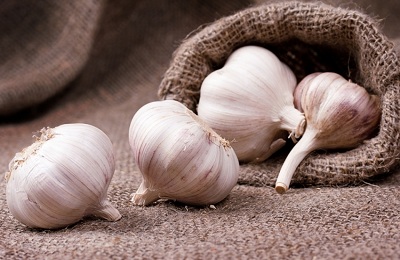
This variety of winter garlic is intended for cultivation in a temperate climate zone. It is successfully cultivated both in private household plots and in farms. Moscow region refers to winter, arrow-type garlic. Planted in the winter (3-4 weeks before the steady freezing of the soil). It has such characteristic features:
TIPS OF PROFESSIONAL GARDENERSMany of our readers for the HIGH HARVEST are actively using the effective biological fertilizer Biogrow. This fertilizer is suitable for all types and varieties of plants grown. Allows increase yield by 50% WITHOUT hazardous chemicals. And all that is needed for this is to add bio-fertilizer to the soil 2-3 times per season.
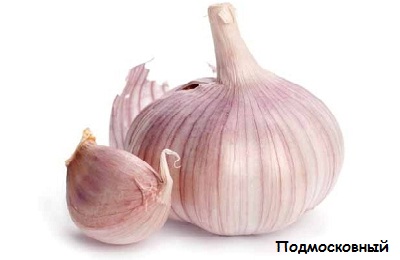
Gribovsky
Gribovsky - a popular winter variety cultivated in the Moscow region. There are two types of varieties: Gribovsky Jubilee and Gribovsky-60, which have such distinctive features:
| Specifications | Gribovsky 60 | Gribovsky anniversary |
|---|---|---|
| Maturation | precocious | mid season |
| Timing | 86-97 | 84-121 |
| View | arrowman | arrowman |
| The number of teeth in the head | 7-10 | 8-12 |
| Bulb weight | 40-65 | 25-45 |
| Head shape | flat-round | flat-round |
| Taste qualities | acute | semi-sharp |
| Landing depth | 5-8 cm | 4-6 cm |
| Landing (interrow width) | About 30 cm | 25-30 cm |
| Productivity (m 2) | about 2 kg | 1.3-1.7 kg |
| Scale color | red-lilac | creamy purple |
In general, the variety Gribovsky (jubilee and 60) is excellent against a variety of bacterial bulb infections. With proper care, you can get a big harvest (up to 3 kg / m 2).
The winter arrow of garlic Union was developed by the joint efforts of the Russian and Belarusian breeders. Powerful plant, which accounts for 7-9 dark green leaves (34 cm long). Throws out the arrow with small onions, white and gray. Forms a large dense onion. The variety is characterized by such biological properties:
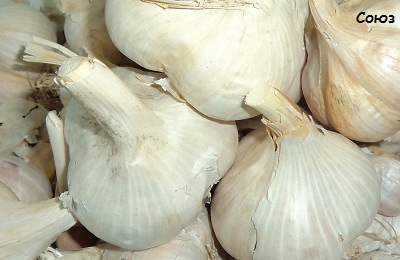
Winter variety Union is very popular. Growing this type of garlic gives a consistently good yield.
The variety has a high resistance to bacterial diseases. It has excellent taste properties, which makes it a universal product.
This variety has high winter-resistance, forms a large, flat-rounded head. It has the following morphological characteristics:
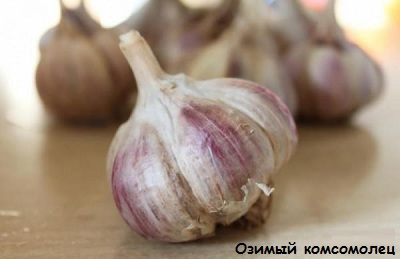
Winter garlic Komsomolets grows well in the loamy lands of the Moscow region. Planting is desirable to produce in open, sunny areas, with such predecessor crops as cucumbers, cabbage, legumes.
The high-yielding mid-season grade intended for cultivation in a midland of Russia. Main characteristics:
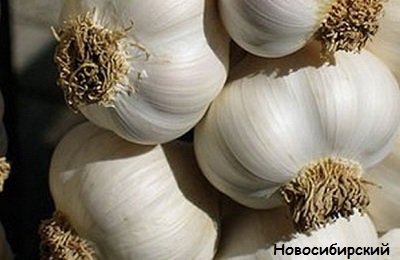
The unpretentious grade differing in high productivity. Properties of the Zubrenok variety:
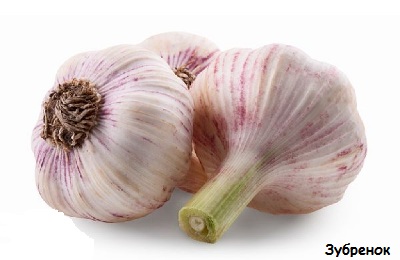
Winter, frost-resistant variety of garlic, universal purpose. The main characteristics of the variety Reliable:
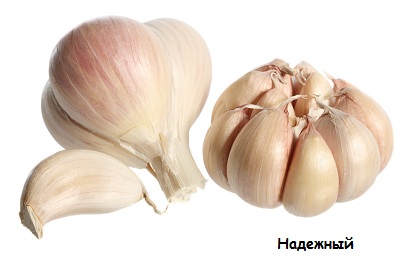
A healthy and, most importantly, high yield is the goal to which everyone who grows garlic aspires.
You can achieve the final result with the help of properly selected planting material. For this it is necessary to take into account the growing conditions and planting time.
Do you still think that it is impossible to get rid of cardiovascular diseases?
- do you often have pain and discomfort in the chest?
- it seems to you that the heart almost “jumps out” of the chest, then freezes for a while ...
- you have shortness of breath even after a little exercise ....
- headaches, poor sleep, feelings of weakness and fatigue ...
- by evening the legs swell ...

